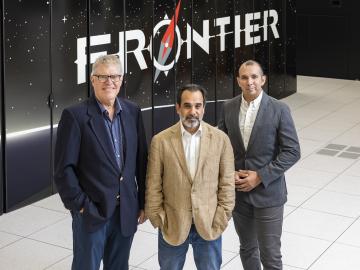
Filter News
Area of Research
News Type
News Topics
- (-) High-Performance Computing (46)
- (-) Partnerships (34)
- 3-D Printing/Advanced Manufacturing (59)
- Advanced Reactors (14)
- Artificial Intelligence (46)
- Big Data (17)
- Bioenergy (29)
- Biology (30)
- Biomedical (21)
- Biotechnology (12)
- Buildings (22)
- Chemical Sciences (44)
- Clean Water (2)
- Composites (14)
- Computer Science (79)
- Coronavirus (17)
- Critical Materials (11)
- Cybersecurity (18)
- Education (3)
- Element Discovery (1)
- Emergency (1)
- Energy Storage (48)
- Environment (51)
- Exascale Computing (23)
- Fossil Energy (1)
- Frontier (24)
- Fusion (19)
- Grid (21)
- Irradiation (1)
- Isotopes (24)
- ITER (3)
- Machine Learning (17)
- Materials (71)
- Materials Science (60)
- Mercury (2)
- Microelectronics (1)
- Microscopy (20)
- Molten Salt (3)
- Nanotechnology (32)
- National Security (23)
- Neutron Science (61)
- Nuclear Energy (36)
- Physics (27)
- Polymers (14)
- Quantum Computing (16)
- Quantum Science (35)
- Security (12)
- Simulation (15)
- Software (1)
- Space Exploration (3)
- Statistics (1)
- Summit (24)
- Transportation (37)
Media Contacts
Verónica Melesse Vergara and Felipe Polo-Garzon, two staff members at ORNL have been honored with Luminary Awards from Great Minds in STEM, a nonprofit organization dedicated to promoting STEM careers in underserved communities.

A multi-institutional team of researchers led by the King Abdullah University of Science and Technology, or KAUST, Saudi Arabia, has been nominated for the Association for Computing Machinery’s 2024 Gordon Bell Prize for Climate Modelling.

ThermoVerse and Expanding Frontiers have made strides in energy innovation by securing wins in Phase 2 of the Department of Energy’s American-Made Lab MATCH Prize, a competition designed to accelerate commercialization of national laboratory technologies.

Two papers led by researchers from ORNL received “Editor’s Choice” awards from the journal Future Generation Computer Systems. Both papers explored the possibilities of integrating quantum computing with high performance computing.

Researchers led by the University of Melbourne, Australia, have been nominated for the Association for Computing Machinery’s 2024 Gordon Bell Prize in supercomputing for conducting a quantum molecular dynamics simulation 1,000 times greater in size and speed than any previous simulation of its kind.

A team led by scientists at ORNL identified and demonstrated a method to process a plant-based material called nanocellulose that reduced energy needs by a whopping 21%, using simulations on the lab’s supercomputers and follow-on analysis.

A study by more than a dozen scientists at the Department of Energy’s Oak Ridge National Laboratory examines potential strategies to integrate quantum computing with the world’s most powerful supercomputing systems in the pursuit of science.

In an impressive showcase of cutting-edge innovation and scientific prowess, ORNL has been recognized as a beacon of technological excellence, receiving 14 R&D 100 Awards, announced this week by R&D World magazine.

Seven entrepreneurs comprise the next cohort of Innovation Crossroads, a DOE Lab-Embedded Entrepreneurship Program node based at ORNL. The program provides energy-related startup founders from across the nation with access to ORNL’s unique scientific resources and capabilities, as well as connect them with experts, mentors and networks to accelerate their efforts to take their world-changing ideas to the marketplace.
The contract will be awarded to develop the newest high-performance computing system at the Oak Ridge Leadership Computing Facility.


